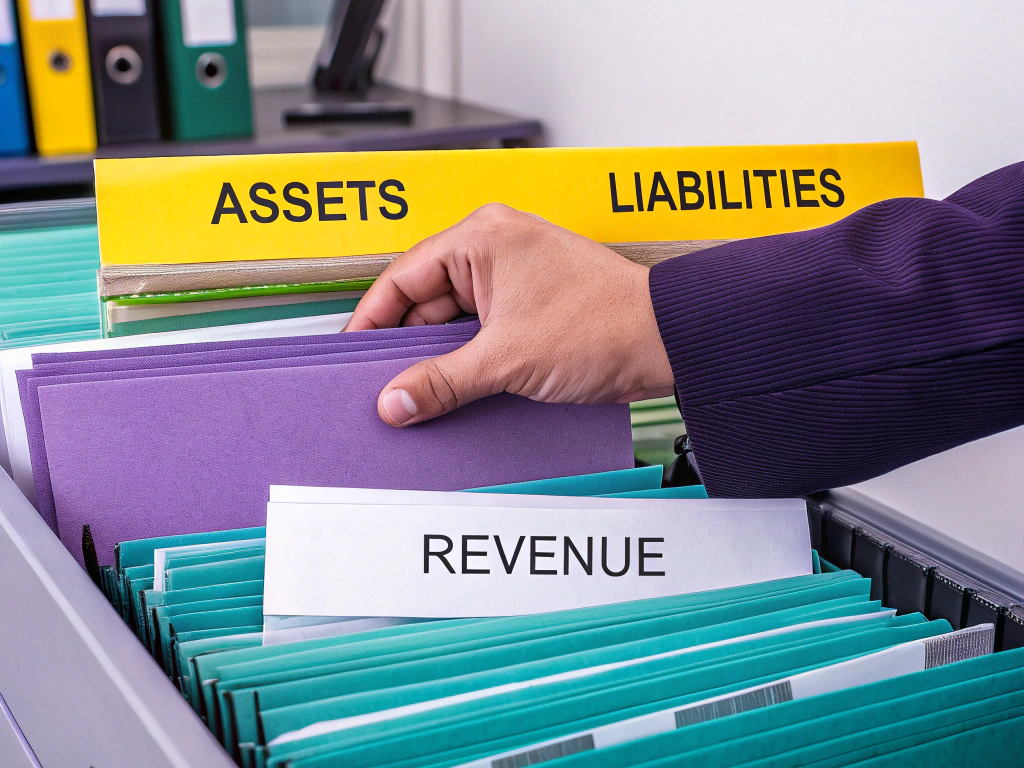Alright, let’s dive into the wild world of general ledger accounts—trust me, it’s more exciting than it sounds (well, almost). Think of the general ledger as your company’s financial diary. It’s where every dollar that comes in or goes out gets recorded, giving you a complete picture of your business’s financial health. Without it, preparing those fancy financial statements would be like trying to bake a cake without a recipe—messy and likely to end in disaster.
So, if you’re using double-entry accounting (don’t worry, we’ll get to that beast in a minute), the general ledger is your new best friend. It’s the place where every transaction gets its time in the spotlight, with both debit and credit entries balancing each other out in perfect harmony. In this guide, we’re going to break down what a general ledger is, explore the different types of general ledger accounts, and show you how to record transactions like a pro (no accounting degree required!).

See also: Business Valuation Methods and Examples
What is a General Ledger?
Let’s get down to brass tacks. A general ledger is essentially the master record of all your company’s financial transactions—a grand repository where every penny is accounted for. Imagine it as the mother of all spreadsheets, with a tab for every account your business uses. From assets and liabilities to equity, expenses, and revenue—it’s all there, organized and ready to spill the beans on your financial position.
An account, in this context, is like a dedicated notebook for a specific type of transaction. So, you’ve got one notebook for cash transactions, another for sales, and maybe even one for “Office Snacks” (because who doesn’t need a stash of gummy bears at 3 p.m.?). The general ledger is the binder that holds all these notebooks together.
Now, you might hear the general ledger referred to as a “book of second entries.” That’s because transactions first get recorded in journals—think of them as the rough drafts of your financial story. Once they’ve been jotted down there, they graduate to the general ledger, where they’re organized and summarized.
The general ledger is crucial because it helps you (and anyone else who cares, like investors or that nosy accountant) assess your company’s financial performance. It gives you a clear picture of where your money’s coming from and where it’s going, which is kind of important when you’re trying to make sound financial decisions. Plus, it’s the foundation for those all-important financial statements—without it, your income statement and balance sheet would be about as reliable as a chocolate teapot.
In short, the general ledger is your financial command center, and understanding it is key to running a tight ship.
General Ledger and Double-Entry Accounting Explained
Alright, time to tackle the not-so-scary beast known as double-entry accounting. Don’t let the fancy name intimidate you—it’s basically a way to make sure your books are balanced, so you don’t end up scratching your head wondering where all your money went.
The principle is simple: every financial transaction affects at least two accounts. For every debit entry, there’s a corresponding credit entry of an equal amount. It’s like the universe’s way of keeping your accounting karma in check—what goes around comes around, and everything stays in balance.
For example, if you buy a new laptop for your business with cash, your equipment account (an asset) increases, and your cash account (also an asset) decreases by the same amount. One account gets debited, the other gets credited, and the books stay balanced. Easy peasy.
The general ledger is where all this action happens. It’s the stage where debits and credits perform their delicate dance, ensuring that every financial move is properly recorded and balanced. Without it, your accounting records would be a hot mess, and nobody wants that.

General Ledger and Financial Statements
Once you’ve got your transactions all nicely recorded in the general ledger, you can start thinking about the big leagues: financial statements. These bad boys—like the cash flow statement, income statement, and balance sheet—tell the story of your company’s financial health in a way that investors, creditors, and yes, the tax man, can understand.
But here’s the kicker: you can’t prepare accurate financial statements without solid data from your general ledger. Think of the general ledger as the ingredients list for your financial cake—you need it to make sure everything comes out just right. The ledger provides the detailed information that feeds into the trial balance, which is then used to create your financial statements.
The trial balance is like a dress rehearsal. It ensures that total debits equal total credits before you move on to the final performance. If everything balances, you’re good to go. If not, it’s back to the ledger to figure out where things went sideways.
Bottom line? A well-maintained general ledger is the foundation of accurate financial statements. And accurate financial statements are essential for making informed decisions, attracting investors, and keeping regulators off your back. So, yes, it’s kind of a big deal.
Types of General Ledger Accounts
- Assets
- Liabilities
- Equity
- Revenue
- Expenses
- Other Income
Now, let’s break these down like a box of chocolates (only with fewer calories). The general ledger organizes these accounts to help you, your investors, and any other interested parties get a clear picture of how your business is doing financially.
Assets
Asset accounts are where you keep track of all the stuff your company owns that has value—think cash, inventory, equipment, and that espresso machine in the break room. When you debit an asset account, you’re increasing its balance (yay, more assets!). When you credit it, you’re decreasing the balance (nobody likes to see assets walking out the door).
Assets are the economic resources of your company and can be tangible, like a fleet of shiny delivery trucks, or intangible, like patents or trademarks. They’re the things that, directly or indirectly, help you generate revenue.
Liabilities
Liability accounts track what your company owes to others—like loans, accounts payable, or that tab you keep running at the office supply store. In this case, credits increase the liability balance (more IOUs), and debits decrease it (paying off debts feels good, doesn’t it?).
Liabilities can be short-term (like bills you need to pay next month) or long-term (like that mortgage on your office building). Keeping a close eye on your liabilities helps you manage your cash flow and avoid any nasty surprises.
Equity
Equity accounts represent the owners’ stake in the company. This includes things like common stock, retained earnings, and treasury stock. It’s basically what’s left over after you subtract liabilities from assets—kind of like the sprinkles on top of your financial cupcake.
Equity can increase through profits or investments and decrease through losses or distributions to owners (like dividends). It’s important because it shows the net value of the company from the owners’ perspective.
Revenue
Revenue accounts are all about the money your company earns from its regular business activities—selling products, providing services, or maybe even holding a killer bake sale. Credits increase revenue accounts (more money coming in), while debits decrease them (returns or refunds, anyone?).
Having detailed revenue accounts helps you understand which of your products or services are making bank and which might need a little TLC or a swift kick to the curb.
Expenses
Expense accounts keep track of all the costs your company incurs to generate revenue—things like rent, utilities, salaries, and supplies. Debits increase expense accounts (more money going out), and credits decrease them (refunds or rebates).
Monitoring your expenses is crucial for budgeting and finding areas where you might be able to save a few bucks (or thousands). After all, reducing expenses goes straight to your bottom line.
Non-Operating or Other Income Accounts
These accounts capture income and expenses that aren’t part of your core business operations. Maybe you received a rent payment or earned interest on an investment. These aren’t regular occurrences, but they still affect your financial picture.
Non-operating income accounts help separate the regular, repeatable income streams from the one-off events, giving you a clearer view of how your main business activities are performing.

How to Prepare a General Ledger
Ready to roll up your sleeves and get into the nitty-gritty? Here’s how you prepare a general ledger that’ll make your accountant shed a tear of joy:
- Name Your Accounts: Start by writing the name of each account at the top of a separate page or section. This makes it easier to find and organize transactions later on. Each account gets its own page because, well, they’re special like that.
- Add Account Numbers: Assign a unique number to each account and note it under the account name. This keeps things neat and tidy, especially when you’re dealing with a gazillion transactions.
- Record Transactions Chronologically: Enter each transaction in the order it happens. This chronological order helps you track the flow of activities and makes it a breeze to find specific entries when you need them. Say goodbye to playing hide-and-seek with your finances.
- Determine Debits and Credits: Decide whether each transaction increases or decreases the account balance. Remember, assets and expenses increase with debits and decrease with credits. Liabilities, equity, and revenue do the opposite—increasing with credits and decreasing with debits. It’s like learning dance steps, but for numbers.
Once all transactions are recorded, it’s time to make sure the books balance. Total up the debits and credits for each account and ensure they match. If they don’t, you’ve got yourself a mystery to solve—time to put on your detective hat and look for errors or omissions.
Examples: Types of Ledger Accounts
Example 1
Let’s say on March 1, a business owner receives $700 from a Customer. On March 15, they purchase goods worth $200 in cash. Here’s how the entries would look:
Cash Account:
| Date | Description | Ref. | Debit ($) | Credit ($) |
| March 1 | Received from Customer | 700 | ||
| March 15 | Purchased Goods | 200 |
Customer Account:
| Date | Description | Ref. | Debit ($) | Credit ($) |
| March 1 | Cash | 700 |
Goods Account (Inventory, Equipment):
| Date | Description | Ref. | Debit ($) | Credit ($) |
| March 15 | Cash | 200 |
In this example, the cash account gets debited when cash increases (you received money—woohoo!) and credited when cash decreases (you spent money—boo). The customer account is credited because they owe you less money after paying up. The goods account (an asset) is debited because you now have more goods in stock.
See how everything stays balanced? It’s the accounting circle of life.

Example 2
On July 16, 2018, a textile company sells goods for cash totaling $45,000. The journal entry would be:
| Date | Account | Debit ($) | Credit ($) |
| July 16, 2018 | Cash | 45,000 | |
| Sales | 45,000 |
The general ledger entries would look like this:
Cash Account:
| Date | Description | Ref. | Debit ($) | Credit ($) |
| July 16 | Received from Customer | 45,000 |
Sales account:
| Date | Description | Ref. | Debit ($) | Credit ($) |
| July 16 | Goods sold | 45,000 |
Here, the cash account is debited because cash increased, and the sales (revenue) account is credited because revenue also increased. Simple, right?
Example 3
On January 1, a company receives $10,000 from a customer. On January 9, it purchases goods worth $4,000. On January 11, it pays $1,000 in rent. Let’s prepare the general ledger entries:
Cash Account:
| Date | Description | Ref. | Debit ($) | Credit ($) |
| January 1 | Received from the Customer | 10,000 | ||
| January 9 | Purchased Goods | 4,000 | ||
| January 11 | Paid Rent | 1,000 | ||
| Totals | 10,000 | 5,000 |
After accounting for all transactions, the cash account shows a balance of $5,000 (cash in minus cash out). The other accounts would be updated similarly, each reflecting their respective increases or decreases.
Remember, the goal is to keep the books balanced, ensuring debits equal credits across all accounts.
Importance of the General Ledger
- Foundation of Financial Statements
- Accurate Tax Filing
- Comprehensive Transaction Record
Foundation of Financial Statements
Your financial statements are only as good as the data in your general ledger. Without accurate records, your income statement might as well be a work of fiction. The general ledger provides the detailed information needed to prepare financial statements that reflect your company’s true financial position. This is essential for decision-making, securing financing, and satisfying regulatory requirements.
Accurate Tax Filing
Nobody enjoys dealing with taxes (except maybe tax accountants), but your general ledger makes the process less painful. It keeps a detailed record of all your income and expenses, ensuring you report accurate figures to the tax authorities. Whether you’re filing income taxes, sales taxes, or payroll taxes, the general ledger has got your back.
Comprehensive Transaction Record
Need to find a specific transaction from six months ago? Instead of sifting through piles of receipts and invoices, you can turn to your general ledger. It provides a complete, organized record of every financial transaction, saving you time and keeping stress levels in check.
See also: Consolidated Statement of Financial Position
Wrapping Up
The general ledger might not be the flashiest part of running a business, but it’s undeniably one of the most important. It keeps your financial affairs in order, helps you make informed decisions, and ensures you’re in good standing with everyone from investors to the tax man. So embrace the general ledger—give it the attention it deserves—and watch your business thrive.
